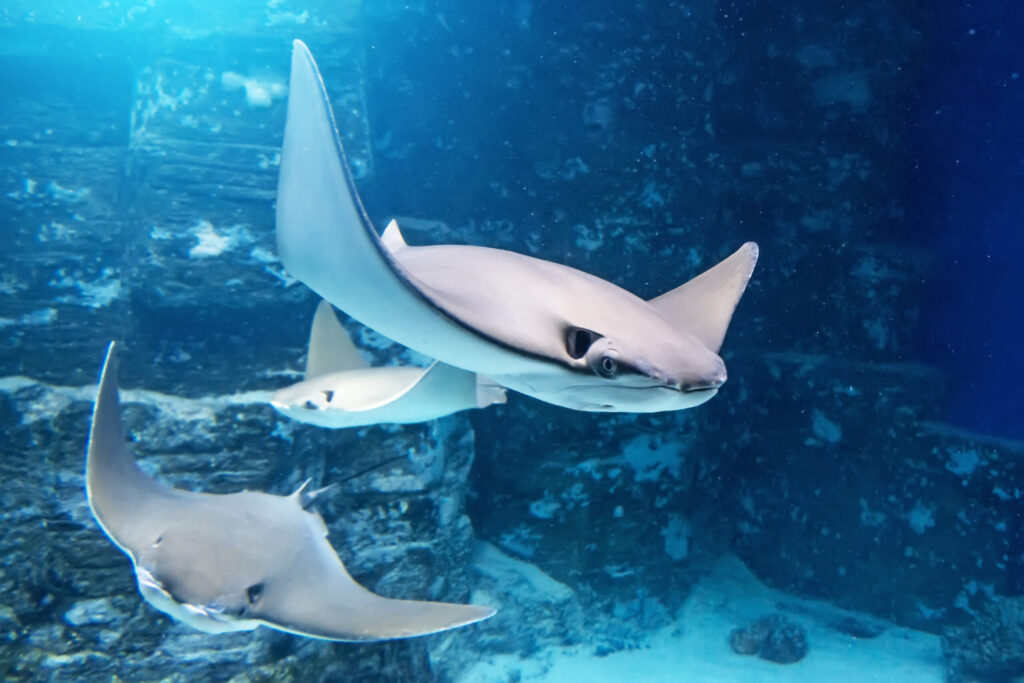In the hidden recesses of the ocean, concealed beneath the sand or gliding gracefully through the water, stingrays are enigmatic creatures that have intrigued marine enthusiasts for centuries. Their distinct appearance, remarkable adaptations, and sometimes elusive presence make them captivating subjects of study. In this educational exploration, we plunge into the realm of stingray species, uncovering the mysteries that shroud these intriguing sea-dwellers. From their anatomy and behaviour to their ecological significance and conservation challenges, join us on a journey to unveil the secrets of stingrays in all their diversity.
Table of Contents
Nature’s Submarine Stealth Artists
- Introduction to Stingrays: They are a diverse group of elasmobranchs, the subclass of cartilaginous fish that includes sharks and rays. Their distinctive flattened bodies, enlarged pectoral fins, and long tails with venomous spines make them stand out in the marine world.
- Species Diversity: Rays encompass a variety of species, each with unique characteristics. Some are known for their striking appearance, while others remain hidden beneath the sand or in the depths of the ocean.
Anatomy and Behavior
- Body Structure: They possess a flattened body, which allows them to seamlessly blend with the ocean floor. Their wing-like pectoral fins are used for graceful gliding through the water, while their tails, often equipped with venomous spines, serve as a defence mechanism.
- Unique Feeding Habits: They are predominantly carnivorous, preying on small fish, crustaceans, and mollusks. Their feeding methods vary between species, from suction feeding to bottom-dwelling foraging.
- Mysterious Sand Dwellers: Some species, like the blue spotted ribbon tail stingray (Taeniura lymma), are masters of camouflage. They bury themselves in the sand, leaving only their eyes and spiracles exposed, waiting for unsuspecting prey to pass by.
The Diverse World of Stingray Species
- Blue Spotted Ribbontail Stingray (Taeniura lymma): This small but striking species is known for its vivid blue spots and ribbontail. It is frequently observed in shallow tropical waters and reef systems.
- Southern Stingray (Hypanus americanus): The southern stingray is recognized by its diamond-shaped body and long, whip-like tail. It’s often found along the coasts of the western Atlantic Ocean.
- Manta Ray (Manta birostris): Although mantas are often referred to as rays, they are a distinct subgroup known for their enormous size and graceful movements. Their filter-feeding habits set them apart from other stingrays.
- Electric Ray (Torpedo marmorata): Electric rays possess the unique ability to generate electric shocks, which they use for both hunting and self-defense. Their physiology and behavior make them stand out among stingray species.
- Stingarees: Stingarees belong to the family Urolophidae and are characterized by their disc-shaped bodies and venomous spines. They are often found along the coasts of Australia.
Reproduction and Life Cycle
- Viviparous Reproduction: Most of this species are viviparous, giving birth to live young after an internal gestation period. This reproductive strategy varies among species, with some exhibiting complex courtship behaviours.
- Maternal Care: Some, like the southern stingray, provide maternal care by nurturing their pups in specialized nursery areas. These nurseries play a crucial role in the survival of young stingrays.
Ecosystems and Conservation
- Ecological Significance: They play a vital role in marine ecosystems by controlling populations of prey species and serving as prey themselves. They help maintain the delicate balance of food chains in their respective habitats.
- Conservation Challenges: Despite their ecological importance, many face threats such as overfishing, habitat degradation, and accidental capture. Conservation efforts are necessary to protect these creatures and the ecosystems they inhabit.
Rays and Humans: Interaction and Impacts
- Stingrays and Humans: Rays have garnered significant attention due to their interactions with humans. While they are generally docile creatures, accidents involving their venomous spines have occurred, highlighting the need for caution and awareness.
- Stingray Tourism: Human encounters have become a popular tourist attraction in some regions, such as the Stingray City sandbar in the Cayman Islands. Responsible tourism practices are essential to minimize disturbances to stingrays and their habitats.
Conservation Initiatives and theie Future
- Data Collection and Research: Conservation initiatives often involve the collection of data on stingray populations, their habitats, and migratory patterns. This research is instrumental in developing effective conservation strategies.
- Marine Protected Areas: Establishing marine protected areas is a crucial step in safeguarding the habitats of stingrays and other marine life. These areas help reduce human impact on their ecosystems.
Conclusion: Their Hidden World
As we conclude our journey into their diverse world, we come to appreciate the remarkable adaptations, behaviours, and ecological roles of these enigmatic creatures. From the striking blue spotted ribbon tail stingray to the electric rays’ unique abilities, the realm of stingrays is rich with diversity and complexity.
Preserving them for future generations is crucial, emphasizing the significance of conservation and responsible engagement. These enigmatic ocean dwellers contribute to the intrigue of the underwater world and showcase the complexities of marine life.
Related Articles
Click here to read the article “”.
